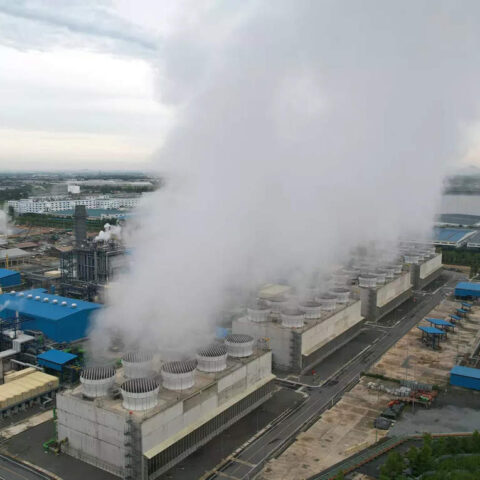
By Colliers Canada
Many of yesterday’s industrial parks are no longer designed and equipped to meet the needs and wants of businesses today and tomorrow. The same could be said for many industrial projects that are being developed right now.
For Canada’s industrial inventory and the businesses that use that space, that’s just not going to cut it anymore.
The team behind KingJane Business Park in King City, Ontario, is working on an immense industrial development with next-generation design technology for the growing number of tenants and users that must have scale, convenient access, top-shelf amenities, flexibility and a certified zero-carbon footprint.
KingJane Business Park is the largest Carbon Zero Certified industrial development underway in the GTA. The campus, located at the crossroads of King Road and Jane Street, with direct access to Highway 400 Interchange, will soon offer five state-of-the-art industrial buildings ranging from 132,000 square feet to 560,660 square feet. The first phase of the 1.7 million-square-foot campus is set to open to users in early 2025.
Zero-carbon is becoming a corporate must
“We’re not only looking at the initial lease-up of that site, but what the future tenants will need as well,” says Nick Stryland, Vice President, Asset Management, Nicola Institutional Realty Advisors (NIRA), which is developing the property for Nicola Wealth Real Estate and two large institutional clients. “Zero-carbon certification is central to future-proofing industrial assets.”
NIRA is a fully-owned subsidiary of Nicola Wealth Management. The company provides real estate investment advisory, asset management and transaction services to Canadian pension funds, foreign investors, private investors, and both public and private sector companies.
“We’re providing buildings that align with companies’ ESG goals, which are increasingly evolving from net zero carbon-ready, to certified,” Stryland says. “Developing buildings like this also aligns with our clients’ and our own company’s sustainability goals.”
To achieve net-zero certification, KingJane has several design elements that eliminate the use of gas and reduce energy consumption, says Minesh Dave, Vice President, Development at NIRA. “One of the key elements is the building envelope.”
That includes using thicker insulated metal paneling, higher insulation value for the roofing, and insulated dock doors. The power system will use no gas, instead relying on electricity supplemented by heat pumps and solar power.
Market demand is pushing for zero-carbon
2030 is just around the corner and 42% of Fortune 500 companies have a target to achieve net zero by then, says Colin Alves, Vice Chairman with Colliers, the firm leading the leasing and marketing of KingJane. “We’re already seeing major retail and parcel delivery companies electrifying their fleets, and next on the agenda is achieving net-zero building operations.”
Specifically, Apple, Toyota, Nestlé, Unilever, Ikea, Maersk and Colliers all have pledges to achieve net-zero carbon by 2030. In Canada, 50-75% of Fortune Global 500 companies have net-zero mandates by 2050, according to Colliers data. “These are global occupiers that are really driving the trend and corporate Canada is following suit,” Alves says. “The list of occupants that are going to be seeking these types of facilities is going to grow exponentially.”
The KingJane complex will open at the right time, Alves adds, noting that overall activity in the local and national industrial sector so far this year is cause for optimism.
“We’re seeing strong levels of leasing activity,” Alves says. “In the GTA, it’s almost a million square feet of net absorption, which is keeping pace with the arrival of new inventory.”
Alves says vacancy is still below the historical pre-pandemic levels. “We still need more space to be delivered to the market to return to balance. We’re just not delivering enough space.”
Employee experience needs to be elevated in an industrial setting
The experience of tenants and workers in Canada’s industrial buildings must be elevated, Stryland says. “Industrial workspaces have really been behind what office workers expect from their environments, and employee attraction and retention is more of a priority now in the industrial sector.”
Stryland says workers are thinking more about their environment and surroundings. “The offshoot of investing more in your workspaces is more productivity.”
At KingJane, that will mean attractive and comfortable amenity spaces outside and natural light and fresh air inside. “We’re basically enhancing everything that we can to ensure that when you show up to work, that facility will give you the best possible experience for your entire shift,” Dave says.
The location of KingJane is within 10 kilometres of nearly 60 restaurants, retail shops, cafes, and other food and beverage providers. More than 1.9 million workers live within a 30-minute commute of the site.
“Centre-ice” location provides logistics opportunities
Toronto has always been constrained by the lake to the south and the greenbelt to the north, which has forced development into the east and west, Stryland says. “It has become congested and saturated because the highway system has not kept pace with development.”
This location to the north in King City has become centre ice for logistics companies that need to move products in and out of the region smoothly.
“When this site became available, it ticked all the boxes,” Stryland says. “It has amazing access to Highway 400, and that means connections to labour and other distribution corridors. Companies in the region are not just distributing around Southern Ontario, but also are servicing Quebec and the Maritimes,” he says. “It’s much tougher now to do that from the west end of the city.”
Stryland says KingJane, with its expansive footprints, 40-foot clear ceiling heights, large staging bay and generous truck access will help companies unite all of their operations under one roof.
Manufacturing companies will also fit in well at KingJane due to the facility’s broad column spacing and floor load capacity, Dave says.
Alves adds that Toronto is North America’s largest food and beverage production market outside of Los Angeles and the team expects demand from companies in that sector. “Food and beverage is one of the major drivers of growth of our industrial market as companies try to meet the demands of a growing population.”
How NIRA is getting this done
Collaboration and synchronization are keys to getting a project like this done, in the right way, Dave says. That requires having construction management, the development team, consultants and trades teams working in unison and meeting in-person frequently, and from the start. Part of this collaboration is having a great partnership with municipal staff. King City has been supportive of NIRA’s ESG initiatives.
“Together, we must continually ask ourselves what is possible, and then figure out together how to get it done,” Dave says. “Does it work in this environment? Does the normal process need to be shaken up? Is there a new way to do this?”
The industrial market isn’t going to wait around as other developers search for the answers to those questions.







